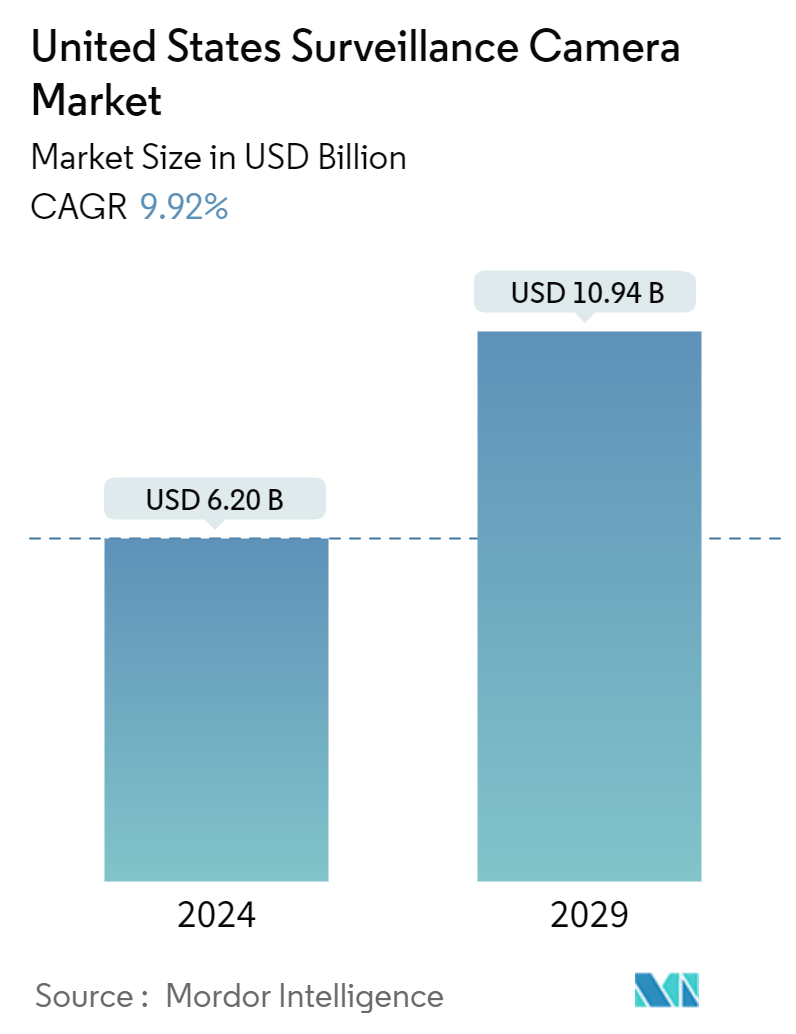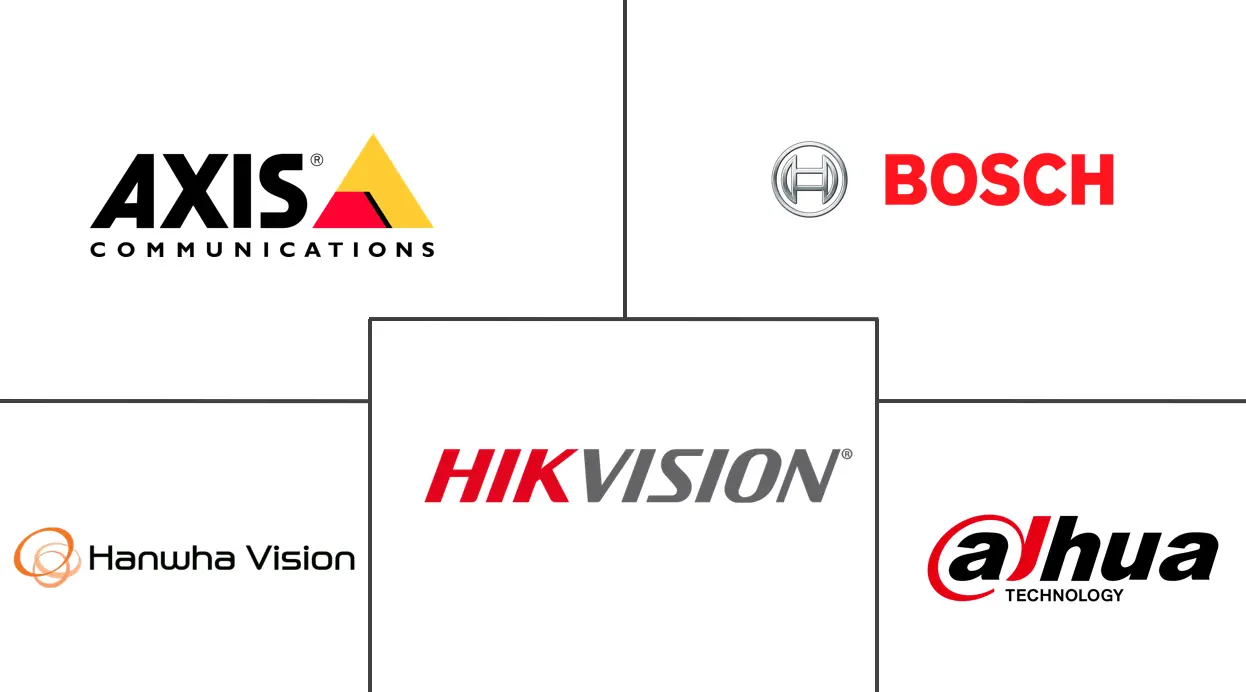Market Size of United States Surveillance Camera Industry

| Study Period | 2019 - 2029 |
| Base Year For Estimation | 2023 |
| Market Size (2024) | USD 6.20 Billion |
| Market Size (2029) | USD 10.94 Billion |
| CAGR (2024 - 2029) | 9.92 % |
| Market Concentration | Low |
Major Players
*Disclaimer: Major Players sorted in no particular order |
United States Surveillance Camera Market Analysis
The United States Surveillance Camera Market size is estimated at USD 6.20 billion in 2024, and is expected to reach USD 10.94 billion by 2029, growing at a CAGR of 9.92% during the forecast period (2024-2029).
- Over the past decade, the United States surveillance camera market has grown significantly, propelled by technological advancements, rising security concerns, and evolving regulations. Advancements in AI and ML have revolutionized surveillance systems. They bolster video analytics, enabling sophisticated features like facial recognition, behavior analysis, and object detection, enhancing system efficacy. Furthermore, the increasing adoption of Internet of Things (IoT) technology has streamlined connectivity and enabled remote monitoring, elevating the efficiency and user-friendliness of surveillance systems.
- Moreover, the US's macroeconomic conditions have been conducive to market growth, buoyed by heightened government spending on public safety. Notably, the US government allocated a substantial budget of USD 45.7 billion for the Department of Justice in FY2025, underscoring its commitment to security initiatives and setting a positive trajectory for the surveillance camera market.
- Several trends are reshaping the market landscape—notably, a pronounced shift towards cloud-based surveillance solutions, offering scalable storage and enhanced accessibility. Wireless cameras are gaining momentum and are lauded for their flexibility and straightforward installation. Furthermore, the trend of integrating surveillance systems with other smart devices and platforms is on a sharp rise.
- Cameras have evolved from video surveillance tools to pivotal AIoT (Artificial Intelligence of Things) components in the Internet of Everything. Companies are honing their visual technology, bolstering multi-dimensional perception, expanding application horizons, and spearheading the digitization of various sectors. This concerted effort aims to lay a robust foundation for intelligent applications.
- Moreover, companies are delving deeper into optical imaging research. They focus on overcoming traditional camera limitations, such as restricted views, night-time image clarity, and limited intelligent applications. This drive manifests in product enhancements, emphasizing ultra-HD, full-color, and panoramic details. Manufacturers also enhance night-time adaptability, highlighting features like full-color zoom capabilities, large aperture zooms, and stable light amounts for vivid picture quality.
- Several major US cities are heavily surveilled, with an average of over ten cameras per 1,000 residents. These cameras serve many functions, from traffic monitoring to crime prevention. Modern surveillance cameras boast high resolutions, offer remote access to live streams, and incorporate advanced technologies like facial and automatic license plate recognition (ALPR), cementing their status as a cornerstone of contemporary security measures.
- While challenges persist, such as heightened public awareness of privacy concerns leading to potential resistance against widespread surveillance and prompting stricter regulations, the market's adoption could be impacted. Additionally, as surveillance systems grow more interconnected, they face an escalating cyber-attack risk. Yet, implementing robust cybersecurity measures, though essential, can be both costly and technically demanding.
- Under the USD 1.9 trillion American Rescue Plan, the US government allocated USD 15 billion specifically for public safety initiatives. A recent report highlights a notable drop in crime rates nationwide, attributed to the increased focus on public safety. Notably, data from approximately 13,000 law enforcement agencies, covering about 82% of the US population, revealed a 13% decrease in murders and 6% and 4% drops in reported violent and property crimes, respectively, in 2023 compared to 2022. Despite these improvements, the demand for surveillance cameras is unlikely to wane. There's a growing trend of heightened investments in security products by consumers, businesses, and governments, aiming to fortify their premises and bolster public safety.
United States Surveillance Camera Industry Segmentation
Surveillance cameras capture and record video footage for security and monitoring. They are used in public spaces, businesses, and homes to deter crime and enhance safety. The study tracks the revenue accrued through the sale of surveillance camera products by various players operating in the United States as the baseline for market estimations. The study also tracks the key market parameters, underlying growth influencers, and major vendors operating in the industry, which supports the market estimations and growth rates over the forecast period.
The United States surveillance camera market is segmented by type (analog-based, IP-based) and end-user industry (government, banking, healthcare, transportation & logistics, industrial, retail, and others). The market sizes and forecasts are provided in terms of value (USD) for all the above segments.
| By Type | |
| Analog-based | |
| IP-based |
| By End-user Industry | |
| Government | |
| Banking | |
| Healthcare | |
| Transportation & Logistics | |
| Industrial | |
| Retail | |
| Other End-user Industries |
United States Surveillance Camera Market Size Summary
The United States surveillance camera market is experiencing robust growth, driven by technological advancements and increasing security concerns. The integration of artificial intelligence and machine learning has significantly enhanced the capabilities of surveillance systems, enabling features such as facial recognition and behavior analysis. The adoption of Internet of Things (IoT) technology has further improved connectivity and remote monitoring, making surveillance systems more efficient and user-friendly. The market is also benefiting from favorable macroeconomic conditions, with substantial government investment in public safety initiatives. This has led to a shift towards cloud-based surveillance solutions, which offer scalable storage and enhanced accessibility, as well as a rise in wireless cameras due to their flexibility and ease of installation.
The market landscape is characterized by a fragmented competitive environment, with both domestic and international players offering advanced surveillance technologies. Companies are focusing on integrating surveillance systems with other smart devices and platforms, and there is a growing trend towards IP-based cameras, which provide high-resolution video quality and remote access. The retail sector, in particular, is witnessing a surge in surveillance camera adoption for loss prevention and customer safety. Despite challenges such as privacy concerns and cyber-attack risks, the demand for surveillance cameras remains strong, supported by the increasing need for security across various sectors. The market is poised for continued growth, driven by ongoing technological innovations and the expanding application of surveillance systems.
United States Surveillance Camera Market Size - Table of Contents
-
1. MARKET INSIGHTS
-
1.1 Market Overview
-
1.2 Industry Attractiveness - Porter's Five Forces Analysis
-
1.2.1 Bargaining Power of Suppliers
-
1.2.2 Bargaining Power of Consumers
-
1.2.3 Threat of New Entrants
-
1.2.4 Threat of Substitutes
-
1.2.5 Intensity of Competitive Rivalry
-
-
1.3 An Assessment of Impact of Macroeconomic Trends on The Market
-
-
2. MARKET SEGMENTATION
-
2.1 By Type
-
2.1.1 Analog-based
-
2.1.2 IP-based
-
-
2.2 By End-user Industry
-
2.2.1 Government
-
2.2.2 Banking
-
2.2.3 Healthcare
-
2.2.4 Transportation & Logistics
-
2.2.5 Industrial
-
2.2.6 Retail
-
2.2.7 Other End-user Industries
-
-
United States Surveillance Camera Market Size FAQs
How big is the United States Surveillance Camera Market?
The United States Surveillance Camera Market size is expected to reach USD 6.20 billion in 2024 and grow at a CAGR of 9.92% to reach USD 10.94 billion by 2029.
What is the current United States Surveillance Camera Market size?
In 2024, the United States Surveillance Camera Market size is expected to reach USD 6.20 billion.

